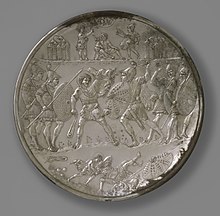


The David Plates (or Cyprus Plates) are a set of nine silver plates, in three sizes, stamped between 613 and 630. The plates were created in Constantinople, each depicting a scene from the life of the Hebrew king David, and associated with the reign of Emperor Heraclius (610-641).[1] Following their discovery in Karavas (northern Cyprus) in 1902, the David Plates have been considered key additions to early Byzantine secular art.
Casual laborers from the village of Karavas found the David Plates with other silver as they were quarrying the ruins for construction stones.[2] The whole hoard is sometimes known as the "Second Cyprus Treasure", the "First Cyprus Treasure" being what is now usually called the Lambousa Treasure (mostly religious plate, now in the British Museum).[3] The finders, however, failed to report what they had discovered to the Cypriot authorities. When authorities learned of their taking they confiscated three of the David Plates alongside a pair of cross-monogram plates, and other jewelry held today in the Museum of Antiquities in Nicosia. The rest of the discovery was smuggled from Cyprus and traded to a dealer located in Paris. Most of this hoard was bought by J. Pierpont Morgan and was later given to the Metropolitan Museum of Art in New York City by his heirs in 1917, where they currently remain.
- ^ Cormack, Robin. Byzantine Art. Oxford U. Press. 2000. Print. p. 63.
- ^ Leader, Ruth. "The David Plates Revisited: Transforming the Secular in Early Byzantium". The Art Bulletin, Vol. 82, No 3 (Sept. 2000) pgs 407-427. https://www.jstor.org/stable/3051395
- ^ "The Cyprus Treasure"